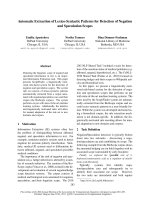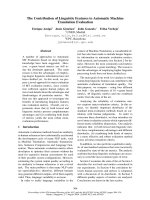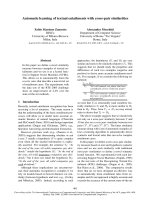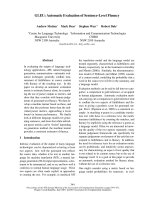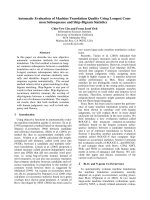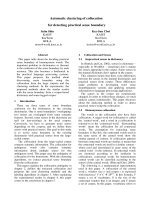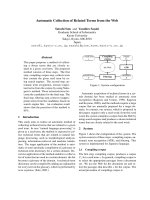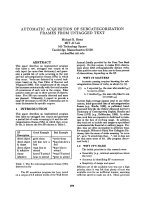Báo cáo khoa học: "Automatic Evaluation of Linguistic Quality in Multi-Document Summarization" pptx
Bạn đang xem bản rút gọn của tài liệu. Xem và tải ngay bản đầy đủ của tài liệu tại đây (202.41 KB, 11 trang )
Proceedings of the 48th Annual Meeting of the Association for Computational Linguistics, pages 544–554,
Uppsala, Sweden, 11-16 July 2010.
c
2010 Association for Computational Linguistics
Automatic Evaluation of Linguistic Quality in Multi-Document
Summarization
Emily Pitler, Annie Louis, Ani Nenkova
Computer and Information Science
University of Pennsylvania
Philadelphia, PA 19104, USA
epitler,lannie,
Abstract
To date, few attempts have been made
to develop and validate methods for au-
tomatic evaluation of linguistic quality in
text summarization. We present the first
systematic assessment of several diverse
classes of metrics designed to capture var-
ious aspects of well-written text. We train
and test linguistic quality models on con-
secutive years of NIST evaluation data in
order to show the generality of results. For
grammaticality, the best results come from
a set of syntactic features. Focus, coher-
ence and referential clarity are best evalu-
ated by a class of features measuring local
coherence on the basis of cosine similarity
between sentences, coreference informa-
tion, and summarization specific features.
Our best results are 90% accuracy for pair-
wise comparisons of competing systems
over a test set of several inputs and 70%
for ranking summaries of a specific input.
1 Introduction
Efforts for the development of automatic text sum-
marizers have focused almost exclusively on im-
proving content selection capabilities of systems,
ignoring the linguistic quality of the system out-
put. Part of the reason for this imbalance is the
existence of ROUGE (Lin and Hovy, 2003; Lin,
2004), the system for automatic evaluation of con-
tent selection, which allows for frequent evalua-
tion during system development and for report-
ing results of experiments performed outside of
the annual NIST-led evaluations, the Document
Understanding Conference (DUC)
1
and the Text
Analysis Conference (TAC)
2
. Few metrics, how-
ever, have been proposed for evaluating linguistic
1
/>2
/>quality and none have been validated on data from
NIST evaluations.
In their pioneering work on automatic evalua-
tion of summary coherence, Lapata and Barzilay
(2005) provide a correlation analysis between hu-
man coherence assessments and (1) semantic re-
latedness between adjacent sentences and (2) mea-
sures that characterize how mentions of the same
entity in different syntactic positions are spread
across adjacent sentences. Several of their models
exhibit a statistically significant agreement with
human ratings and complement each other, yield-
ing an even higher correlation when combined.
Lapata and Barzilay (2005) and Barzilay and
Lapata (2008) both show the effectiveness of
entity-based coherence in evaluating summaries.
However, fewer than five automatic summarizers
were used in these studies. Further, both sets
of experiments perform evaluations of mixed sets
of human-produced and machine-produced sum-
maries, so the results may be influenced by the
ease of discriminating between a human and ma-
chine written summary. Therefore, we believe it is
an open question how well these features predict
the quality of automatically generated summaries.
In this work, we focus on linguistic quality eval-
uation for automatic systems only. We analyze
how well different types of features can rank good
and poor machine-produced summaries. Good
performance on this task is the most desired prop-
erty of evaluation metrics during system develop-
ment. We begin in Section 2 by reviewing the
various aspects of linguistic quality that are rel-
evant for machine-produced summaries and cur-
rently used in manual evaluations. In Section 3,
we introduce and motivate diverse classes of fea-
tures to capture vocabulary, sentence fluency, and
local coherence properties of summaries. We eval-
uate the predictive power of these linguistic qual-
ity metrics by training and testing models on con-
secutive years of NIST evaluations (data described
544
in Section 4). We test the performance of differ-
ent sets of features separately and in combination
with each other (Section 5). Results are presented
in Section 6, showing the robustness of each class
and their abilities to reproduce human rankings of
systems and summaries with high accuracy.
2 Aspects of linguistic quality
We focus on the five aspects of linguistic qual-
ity that were used to evaluate summaries in DUC:
grammaticality, non-redundancy, referential clar-
ity, focus, and structure/coherence.
3
For each of
the questions, all summaries were manually rated
on a scale from 1 to 5, in which 5 is the best.
The exact definitions that were provided to the
human assessors are reproduced below.
Grammaticality: The summary should have no datelines,
system-internal formatting, capitalization errors or obviously
ungrammatical sentences (e.g., fragments, missing compo-
nents) that make the text difficult to read.
Non-redundancy: There should be no unnecessary repeti-
tion in the summary. Unnecessary repetition might take the
form of whole sentences that are repeated, or repeated facts,
or the repeated use of a noun or noun phrase (e.g., “Bill Clin-
ton”) when a pronoun (“he”) would suffice.
Referential clarity: It should be easy to identify who or what
the pronouns and noun phrases in the summary are referring
to. If a person or other entity is mentioned, it should be clear
what their role in the story is. So, a reference would be un-
clear if an entity is referenced but its identity or relation to
the story remains unclear.
Focus: The summary should have a focus; sentences should
only contain information that is related to the rest of the sum-
mary.
Structure and Coherence: The summary should be well-
structured and well-organized. The summary should not just
be a heap of related information, but should build from sen-
tence to sentence to a coherent body of information about a
topic.
These five questions get at different aspects of
what makes a well-written text. We therefore pre-
dict each aspect of linguistic quality separately.
3 Indicators of linguistic quality
Multiple factors influence the linguistic quality of
text in general, including: word choice, the ref-
erence form of entities, and local coherence. We
extract features which serve as proxies for each of
the factors mentioned above (Sections 3.1 to 3.5).
In addition, we investigate some models of gram-
maticality (Chae and Nenkova, 2009) and coher-
ence (Graesser et al., 2004; Soricut and Marcu,
2006; Barzilay and Lapata, 2008) from prior work
(Sections 3.6 to 3.9).
3
/>duc/duc2006/quality-questions.txt
All of the features we investigate can be com-
puted automatically directly from text, but some
require considerable linguistic processing. Several
of our features require a syntactic parse. To extract
these, all summaries were parsed by the Stanford
parser (Klein and Manning, 2003).
3.1 Word choice: language models
Psycholinguistic studies have shown that people
read frequent words and phrases more quickly
(Haberlandt and Graesser, 1985; Just and Carpen-
ter, 1987), so the words that appear in a text might
influence people’s perception of its quality. Lan-
guage models (LM) are a way of computing how
familiar a text is to readers using the distribution
of words from a large background corpus. Bigram
and trigram LMs additionally capture grammati-
cality of sentences using properties of local tran-
sitions between words. For this reason, LMs are
widely used in applications such as generation and
machine translation to guide the production of sen-
tences. Judging from the effectiveness of LMs in
these applications, we expect that they will pro-
vide a strong baseline for the evaluation of at least
some of the linguistic quality aspects.
We built unigram, bigram, and trigram lan-
guage models with Good-Turing smoothing over
the New York Times (NYT) section of the English
Gigaword corpus (over 900 million words). We
used the SRI Language Modeling Toolkit (Stol-
cke, 2002) for this purpose. For each of the three
ngram language models, we include the min, max,
and average log probability of the sentences con-
tained in a summary, as well as the overall log
probability of the entire summary.
3.2 Reference form: Named entities
This set of features examines whether named enti-
ties have informative descriptions in the summary.
We focus on named entities because they appear
often in summaries of news documents and are of-
ten not known to the reader beforehand. In addi-
tion, first mentions of entities in text introduce the
entity into the discourse and so must be informa-
tive and properly descriptive (Prince, 1981; Frau-
rud, 1990; Elsner and Charniak, 2008).
We run the Stanford Named Entity Recognizer
(Finkel et al., 2005) and record the number of
PERSONs, ORGANIZATIONs, and LOCATIONs.
First mentions to people Feature exploration on
our development set found that under-specified
545
references to people are much more disruptive
to a summary than short references to organiza-
tions or locations. In fact, prior work in Nenkova
and McKeown (2003) found that summaries that
have been rewritten so that first mentions of peo-
ple are informative descriptions and subsequent
mentions are replaced with more concise reference
forms are overwhelmingly preferred to summaries
whose entity references have not been rewritten.
In this class, we include features that reflect
the modification properties of noun phrases (NPs)
in the summary that are first mentions to people.
Noun phrases can include pre-modifiers, apposi-
tives, prepositional phrases, etc. Rather than pre-
specifying all the different ways a person expres-
sion can be modified, we hoped to discover the
best patterns automatically, by including features
for the average number of each Part of Speech
(POS) tag occurring before, each syntactic phrase
occurring before
4
, each POS tag occurring after,
and each syntactic phrase occurring after the head
of the first mention NP for a PERSON. To measure
if the lack of pre or post modification is particu-
larly detrimental, we also include the proportion
of PERSON first mention NPs with no words be-
fore and with no words after the head of the NP.
Summarization specific Most summarization
systems today are extractive and create summaries
using complete sentences from the source docu-
ments. A subsequent mention of an entity in a
source document which is extracted to be the first
mention of the entity in the summary is proba-
bly not informative enough. For each type of
named entity (PERSON, ORGANIZATION, LO-
CATION), we separately record the number of in-
stances which appear as first mentions in the sum-
mary but correspond to non-first mentions in the
source documents.
3.3 Reference form: NP syntax
Some summaries might not include people and
other named entities at all. To measure how en-
tities are referred to more generally, we include
features about the overall syntactic patterns found
in NPs: the average number of each POS tag and
each syntactic phrase occurring inside NPs.
4
We define a linear order based on a preorder traversal of
the tree, so syntactic phrases which dominate the head are
considered occurring before the head.
3.4 Local coherence: Cohesive devices
In coherent text, constituent clauses and sentences
are related and depend on each other for their in-
terpretation. Referring expressions such as pro-
nouns link the current utterance to those where the
entities were previously mentioned. In addition,
discourse connectives such as “but” or “because”
relate propositions or events expressed by differ-
ent clauses or sentences. Both these categories
are known cohesive or linking devices in human-
produced text (Halliday and Hasan, 1976). The
mere presence of such items in a text would be in-
dicative of better structure and coherence.
We compute a number of shallow features that
provide a cheap way of capturing the above intu-
itions: the number of demonstratives, pronouns,
and definite descriptions as well as the number of
sentence-initial discourse connectives.
3.5 Local coherence: Continuity
This class of linguistic quality indicators is a com-
bination of factors related to coreference, adjacent
sentence similarity, and summary-specific context
of surface cohesive devices.
Summarization specific Extractive multi-
document summaries often lack appropriate
antecedents for pronouns and proper context for
the use of discourse connectives.
In fact, early work in summarization (Paice,
1980; Paice, 1990) has pointed out that the pres-
ence of cohesive devices described in the previous
section might in fact be the source of problems.
A manual analysis of automatic summaries (Ot-
terbacher et al., 2002) also revealed that anaphoric
references that cannot be resolved and unclear dis-
course relations constitute more than 30% of all
revisions required to manually rewrite summaries
into a more coherent form.
To identify these potential problems, we adapt
the features for surface cohesive devices to indi-
cate whether referring expressions and discourse
connectives appear in the summary with the same
context as in the input documents.
For each of the cohesive devices discussed in
Section 3.4—demonstratives, pronouns, definite
descriptions, and sentence-initial discourse con-
nectives—we compare the previous sentence in
the summary with the previous sentence in the in-
put article. Two features are computed for each
type of cohesive device: (1) number of times the
preceding sentence in the summary is the same
546
as the preceding sentence in the input and (2) the
number of times the preceding sentence in sum-
mary is different from that in the input. Since
the previous sentence in the input text often con-
tains the antecedent of pronouns in the current
sentence, if the previous sentence from the input
is also included in the summary, the pronoun is
highly likely to have a proper antecedent.
Wealso compute the proportion of adjacent sen-
tences in the summary that were extracted from the
same input document.
Coreference Steinberger et al. (2007) compare the
coreference chains in input documents and in sum-
maries in order to locate potential problems. We
instead define a set of more general features re-
lated to coreference that are not specific to sum-
marization and are applicable for any text. Our
features check the existence of proper antecedents
for pronouns in the summary without reference to
the text of the input documents.
We use the publicly available pronoun reso-
lution system described in Charniak and Elsner
(2009) to mark possible antecedents for pronouns
in the summary. We then compute as features the
number of times an antecedent for a pronoun was
found in the previous sentence, in the same sen-
tence, or neither. In addition, we modified the pro-
noun resolution system to also output the probabil-
ity of the most likely antecedent and include the
average antecedent probability for the pronouns
in the text. Automatic coreference systems are
trained on human-produced texts and we expect
their accuracies to drop when applied to automat-
ically generated summaries. However, the predic-
tions and confidence scores still reflect whether
or not possible antecedents exist in previous sen-
tences that match in gender/number, and so may
still be useful for coherence evaluation.
Cosine similarity We use cosine similarity to
compute the overlap of words in adjacent sen-
tences s
i
and s
i+1
as a measure of continuity.
cosθ =
v
s
i
.v
s
i+1
||v
s
i
||||v
s
i+1
||
(1)
The dimensions of the two vectors (v
s
i
and
v
s
i+1
) are the total number of word types from
both sentences s
i
and s
i+1
. Stop words were re-
tained. The value of each dimension for a sentence
is the number of tokens of that word type in that
sentence. We compute the min, max, and average
value of cosine similarity over the entire summary.
While some repetition is beneficial for cohe-
sion, too much repetition leads to redundancy in
the summary. Cosine similarity is thus indicative
of both continuity and redundancy.
3.6 Sentence fluency: Chae and Nenkova
(2009)
We test the usefulness of a suite of 38 shallow
syntactic features studied by Chae and Nenkova
(2009). These features are weakly but signif-
icantly correlated with the fluency of machine
translated sentences. These include sentence
length, number of fragments, average lengths of
the different types of syntactic phrases, total length
of modifiers in noun phrases, and various other
syntactic features. We expect that these structural
features will be better at detecting ungrammatical
sentences than the local language model features.
Since all of these features are calculated over in-
dividual sentences, we use the average value over
all the sentences in a summary in our experiments.
3.7 Coh-Metrix: Graesser et al. (2004)
The Coh-Metrix tool
5
provides an implementation
of 54 features known in the psycholinguistic lit-
erature to correlate with the coherence of human-
written texts (Graesser et al., 2004). These include
commonly used readability metrics based on sen-
tence length and number of syllables in constituent
words. Other measures implemented in the sys-
tem are surface text properties known to contribute
to text processing difficulty. Also included are
measures of cohesion between adjacent sentences
such as similarity under a latent semantic analysis
(LSA) model (Deerwester et al., 1990), stem and
content word overlap, syntactic similarity between
adjacent sentences, and use of discourse connec-
tives. Coh-Metrix has been designed with the
goal of capturing properties of coherent text and
has been used for grade level assessment, predict-
ing student essay grades, and various other tasks.
Given the heterogeneity of features in this class,
we expect that they will provide reasonable accu-
racies for all the linguistic quality measures. In
particular, the overlap features might serve as a
measure of redundancy and local coherence.
5
/>547
3.8 Word coherence: Soricut and Marcu
(2006)
Word co-occurrence patterns across adjacent sen-
tences provide a way of measuring local coherence
that is not linguistically informed but which can
be easily computed using large amounts of unan-
notated text (Lapata, 2003; Soricut and Marcu,
2006). Word coherence can be considered as the
analog of language models at the inter-sentence
level. Specifically, we used the two features in-
troduced by Soricut and Marcu (2006).
Soricut and Marcu (2006) make an analogy to
machine translation: two words are likely to be
translations of each other if they often appear in
parallel sentences; in texts, two words are likely to
signal local coherence if they often appear in ad-
jacent sentences. The two features we computed
are forward likelihood, the likelihood of observ-
ing the words in sentence s
i
conditioned on s
i−1
,
and backward likelihood, the likelihood of observ-
ing the words in sentence s
i
conditioned on sen-
tence s
i+1
. “Parallel texts” of 5 million adjacent
sentences were extracted from the NYT section of
GigaWord. We used the GIZA++
6
implementa-
tion of IBM Model 1 to align the words in adjacent
sentences and obtain all relevant probabilities.
3.9 Entity coherence: Barzilay and Lapata
(2008)
Linguistic theories, and Centering theory (Grosz
et al., 1995) in particular, have hypothesized that
the properties of the transition of attention from
entities in one sentence to those in the next, play a
major role in the determination of local coherence.
Barzilay and Lapata (2008), inspired by Center-
ing, proposed a method to compute the local co-
herence of texts on the basis of the sequences of
entity mentions appearing in them.
In their Entity Grid model, a text is represented
by a matrix with rows corresponding to each sen-
tence in a text, and columns to each entity men-
tioned anywhere in the text. The value of a cell
in the grid is the entity’s grammatical role in that
sentence (Subject, Object, Neither, or Absent). An
entity transition is a particular entity’s role in two
adjacent sentences. The actual entity coherence
features are the fraction of each type of these tran-
sitions in the entire entity grid for the text. One
would expect that coherent texts would contain
a certain distribution of entity transitions which
6
/>would differ from those in incoherent sequences.
We use the Brown Coherence Toolkit
7
(Elsner
et al., 2007) to construct the grids. The tool does
not perform full coreference resolution. Instead,
noun phrases are considered to refer to the same
entity if their heads are identical.
Entity coherence features are the only ones that
have been previously applied with success for pre-
dicting summary coherence. They can therefore
be considered to be the state-of-the-art approach
for automatic evaluation of linguistic quality.
4 Summarization data
For our experiments, we use data from the
multi-document summarization tasks of the Doc-
ument Understanding Conference (DUC) work-
shops (Over et al., 2007).
Our training and development data comes from
DUC 2006 and our test data from DUC 2007.
These were the most recent years in which the
summaries were evaluated according to specific
linguistic quality questions. Each input consists
of a set of 25 related documents on a topic and the
target length of summaries is 250 words.
In DUC 2006, there were 50 inputs to be sum-
marized and 35 summarization systems which par-
ticipated in the evaluation. This included 34 au-
tomatic systems submitted by participants, and a
baseline system that simply extracted the lead-
ing sentences from the most recent article. In
DUC 2007, there were 45 inputs and 32 different
summarization systems. Apart from the leading
sentences baseline, a high performance automatic
summarizer from a previous year was also used
as a baseline. All these automatic systems are in-
cluded in our evaluation experiments.
4.1 System performance on linguistic quality
Each summary was evaluated according to the
five linguistic quality questions introduced in Sec-
tion 2: grammaticality, non-redundancy, referen-
tial clarity, focus, and structure. For each of these
questions, all summaries were manually rated on a
scale from 1 to 5, in which 5 is the best.
The distributions of system scores in the 2006
data are shown in Figure 1. Systems are currently
the worst at structure, middling at referential clar-
ity, and relatively better at grammaticality, focus,
7
/>˜
melsner/
manual.html
548
Figure 1: Distribution of system scores on the five
linguistic quality questions
Gram Non-redun Ref Focus Struct
Content .02 40 * .29 .28 .09
Gram
.38 * .25 .24 .54 *
Non-redun
07 09 .27
Ref
.89 * .76 *
Focus
.80 *
Table 1: Spearman correlations between the man-
ual ratings for systems averaged over the 50 inputs
in 2006; * p < .05
and non-redundancy. Structure is the aspect of lin-
guistic quality where there is the most room for
improvement. The only system with an average
structure score above 3.5 in DUC 2006 was the
leading sentences baseline system.
As can be expected, people are unlikely to be
able to focus on a single aspect of linguistic quality
exclusively while ignoring the rest. Some of the
linguistic quality ratings are significantly corre-
lated with each other, particularly referential clar-
ity, focus, and structure (Table 1).
More importantly, the systems that produce
summaries with good content
8
are not necessar-
ily the systems producing the most readable sum-
maries. Notice from the first row of Table 1 that
none of the system rankings based on these mea-
sures of linguistic quality are significantly posi-
tively correlated with system rankings of content.
The development of automatic linguistic quality
measurements will allow researchers to optimize
both content and linguistic quality.
8
as measured by summary responsiveness ratings on a 1
to 5 scale, without regard to linguistic quality
5 Experimental setup
We use the summaries from DUC 2006 for train-
ing and feature development and DUC 2007
served as the test set. Validating the results on con-
secutive years of evaluation is important, as results
that hold for the data in one year might not carry
over to the next, as happened for example in Con-
roy and Dang (2008)’s work.
Following Barzilay and Lapata (2008), we re-
port summary ranking accuracy as the fraction of
correct pairwise rankings in the test set.
We use a Ranking SVM (SV M
light
(Joachims,
2002)) to score summaries using our features. The
Ranking SVM seeks to minimize the number of
discordant pairs (pairs in which the gold stan-
dard has x
1
ranked strictly higher than x
2
, but the
learner ranks x
2
strictly higher than x
1
). The out-
put of the ranker is always a real valued score, so a
global rank order is always obtained. The default
regularization parameter was used.
5.1 Combining predictions
To combine information from the different feature
classes, we train a meta ranker using the predic-
tions from each class as features.
First, we use a leave-one out (jackknife) pro-
cedure to get the predictions of our features for
the entire 2006 data set. To predict rankings of
systems on one input, we train all the individual
rankers, one for each of the classes of features in-
troduced above, on data from the remaining in-
puts. We then apply these rankers to the sum-
maries produced for the held-out input. By repeat-
ing this process for each input in turn, we obtain
the predicted scores for each summary.
Once this is done, we use these predicted scores
as features for the meta ranker, which is trained on
all 2006 data. To test on a new summary pair in
2007, we first apply each individual ranker to get
its predictions, and then apply the meta ranker.
In either case (meta ranker or individual feature
class), all training is performed on 2006 data, and
all testing is done on 2007 data which guarantees
the results generalize well at least from one year
of evaluation to the next.
5.2 Evaluation of rankings
We examine the predictive power of our features
for each of the five linguistic quality questions in
two settings. In system-level evaluation, we would
like to rank all participating systems according to
549
their performance on the entire test set. In input-
level evaluation, we would like to rank all sum-
maries produced for a single given input.
For input-level evaluation, the pairs are formed
from summaries of the same input. Pairs in which
the gold standard ratings are tied are not included.
After removing the ties, the test set consists of 13K
to 16K pairs for each linguistic quality question.
Note that there were 45 inputs and 32 automatic
systems in DUC 2007. So, there are a total of
45·
32
2
= 22, 320 possible summary pairs.
For system-level evaluation, we treat the real-
valued output of the SVM ranker for each sum-
mary as the linguistic quality score. The 45 indi-
vidual scores for summaries produced by a given
system are averaged to obtain an overall score for
the system. The gold-standard system-level qual-
ity rating is equal to the average human ratings for
the system’s summaries over the 45 inputs. At the
system level, there are about 500 non-tied pairs in
the test set for each question.
For both evaluation settings, a random baseline
which ranked the summaries in a random order
would have an expected pairwise accuracy of 50%.
6 Results and discussion
6.1 System-level evaluation
System-level accuracies for each class of features
are shown in Table 2. All classes of features per-
form well, with at least a 20% absolute increase
in accuracy over the random baseline (50% ac-
curacy). For each of the linguistic quality ques-
tions, the corresponding best class of features
gives prediction accuracies around 90%. In other
words, if these features were used to fully auto-
matically compare systems that participated in the
2007 DUC evaluation, only one out of ten com-
parisons would have been incorrect. These results
set a high standard for future work on automatic
system-level evaluation of linguistic quality.
The state-of-the-art entity coherence features
perform well but are not the best for any of the five
aspects of linguistic quality. As expected, sentence
fluency is the best feature class for grammatical-
ity. For all four other questions, the best feature
set is Continuity, which is a combination of sum-
marization specific features, coreference features
and cosine similarity of adjacent sentences. Conti-
nuity features outperform entity coherence by 3 to
4% absolute difference on referential quality, fo-
cus, and coherence. Accuracies from the language
Feature set
Gram. Redun. Ref. Focus Struct.
Lang. models 87.6 83.0 91.2 85.2 86.3
Named ent.
78.5 83.6 82.1 74.0 69.6
NP syntax
85.0 83.8 87.0 76.6 79.2
Coh. devices
82.1 79.5 82.7 82.3 83.7
Continuity
88.8 88.5 92.9 89.2 91.4
Sent. fluency
91.7 78.9 87.6 82.3 84.9
Coh-Metrix
87.2 86.0 88.6 83.9 86.3
Word coh.
81.7 76.0 87.8 81.7 79.0
Entity coh.
90.2 88.1 89.6 85.0 87.1
Meta ranker 92.9 87.9 91.9 87.8 90.0
Table 2: System-level prediction accuracies (%)
model features are within 1% of entity coherence
for these three aspects of summary quality.
Coh-Metrix, which has been proposed as a com-
prehensive characterization of text, does not per-
form as well as the language model and the en-
tity coherence classes, which contain considerably
fewer features related to only one aspect of text.
The classes of features specific to named enti-
ties and noun phrase syntax are the weakest pre-
dictors. It is apparent from the results that conti-
nuity, entity coherence, sentence fluency and lan-
guage models are the most powerful classes of fea-
tures that should be used in automation of evalu-
ation and against which novel predictors of text
quality should be compared.
Combining all feature classes with the meta
ranker only yields higher results for grammatical-
ity. For the other aspects of linguistic quality, it is
better to use Continuity by itself to rank systems.
One certainly unexpected result is that features
designed to capture one aspect of well-written text
turn out to perform well for other questions as
well. For instance, entity coherence and continuity
features predict grammaticality with very high ac-
curacy of around 90%, and are surpassed only by
the sentence fluency features. These findings war-
rant further investigation because we would not
expect characteristics of local transitions indica-
tive of text structure to have anything to do with
sentence grammaticality or fluency. The results
are probably due to the significant correlation be-
tween structure and grammaticality (Table 1).
6.2 Input-level evaluation
The results of the input-level ranking experiments
are shown in Table 3. Understandably, input-
level prediction is more difficult and the results are
lower compared to the system-level predictions:
even with wrong predictions for some of the sum-
maries by two systems, the overall judgment that
550
one system is better than the other over the entire
test set can still be accurate.
While for system-level predictions the meta
ranker was only useful for grammaticality, at the
input level it outperforms every individual feature
class for each of the five questions, obtaining ac-
curacies around 70%.
These input-level accuracies compare favorably
with automatic evaluation metrics for other nat-
ural language processing tasks. For example, at
the 2008 ACL Workshop on Statistical Machine
Translation, all fifteen automatic evaluation met-
rics, including variants of BLEU scores, achieved
between 42% and 56% pairwise accuracy with hu-
man judgments at the sentence level (Callison-
Burch et al., 2008).
As in system-level prediction, for referential
clarity, focus, and structure, the best feature class
is Continuity. Sentence fluency again is the best
class for identifying grammaticality.
Coh-Metrix features are now best for determin-
ing redundancy. Both Coh-Metrix and Continuity
(the top two features for redundancy) include over-
lap measures between adjacent sentences, which
serve as a good proxy for redundancy.
Surprisingly, the relative performance of the
feature classes at input level is not the same as
for system-level prediction. For example, the lan-
guage model features, which are the second best
class for the system-level, do not fare as well at
the input-level. Word co-occurrence which ob-
tained good accuracies at the system level is the
least useful class at the input level with accuracies
just above chance in all cases.
6.3 Components of continuity
The class of features capturing sentence-to-
sentence continuity in the summary (Section 3.5)
are the most effective for predicting referential
clarity, focus, and structure at the input level.
We now investigate to what extent each of its
components–summary-specific features, corefer-
ence, and cosine similarity between adjacent
sentences–contribute to performance.
Results obtained after excluding each of the
components of continuity is shown in Table 4;
each line in the table represents Continuity mi-
nus a feature subclass. Removing cosine over-
lap causes the largest drop in prediction accuracy,
with results about 10% lower than those for the
complete Continuity class. Summary specific fea-
Feature set
Gram. Redun. Ref. Focus Struct.
Lang. models 66.3 57.6 62.2 60.5 62.5
Named ent.
52.9 54.4 60.0 54.1 52.5
NP Syntax
59.0 50.8 59.1 54.5 55.1
Coh. devices
56.8 54.4 55.2 52.7 53.6
Continuity
61.7 62.5 69.7 65.4 70.4
Sent. fluency
69.4 52.5 64.4 61.9 62.6
Coh-Metrix
65.5 67.6 67.9 63.0 62.4
Word coh.
54.7 55.5 53.3 53.2 53.7
Entity coh.
61.3 62.0 64.3 64.2 63.6
Meta ranker 71.0 68.6 73.1 67.4 70.7
Table 3: Input-level prediction accuracies (%)
tures, which compare the context of a sentence
in the summary with the context in the original
document where it appeared, also contribute sub-
stantially to the success of the Continuity class in
predicting structure and referential clarity. Accu-
racies drop by about 7% when these features are
excluded. However, the coreference features do
not seem to contribute much towards predicting
summary linguistic quality. The accuracies of the
Continuity class are not affected at all when these
coreference features are not included.
6.4 Impact of summarization methods
In this paper, we have discussed an analysis of the
outputs of current research systems. Almost all
of these systems still use extractive methods. The
summarization specific continuity features reward
systems that include the necessary preceding con-
text from the original document. These features
have high prediction accuracies (Section 6.3) of
linguistic quality, however note that the support-
ing context could often contain less important con-
tent. Therefore, there is a tension between strate-
gies for optimizing linguistic quality and for op-
timizing content, which warrants the development
of abstractive methods.
As the field moves towards more abstractive
summaries, we expect to see differences in both
a) summary linguistic quality and b) the features
predictive of linguistic aspects.
As discussed in Section 4.1, systems are cur-
rently worst at structure/coherence. However,
grammaticality will become more of an issue as
systems use sentence compression (Knight and
Marcu, 2002), reference rewriting (Nenkova and
McKeown, 2003), and other techniques to produce
their own sentences.
The number of discourse connectives is cur-
rently significantly negatively correlated with
structure/coherence (Spearman correlation of r =
551
Ref. Focus Struct.
Continuity 69.7 65.4 70.4
- Sum-specific
63.9 64.2 63.5
- Coref
70.1 65.2 70.6
- Cosine
60.2 56.6 60.7
Table 4: Ablation within the Continuity class;
pairwise accuracy for input-level predictions (%)
06, p = .008 on DUC 2006 system summaries).
This can be explained by the fact that they of-
ten lack proper context in an extractive summary.
However, an abstractive system could plan a dis-
course structure and insert appropriate connectives
(Saggion, 2009). In this case, we would expect the
presence of discourse connectives to be a mark of
a well-written summary.
6.5 Results on human-written abstracts
Since abstractive summaries would have markedly
different properties from extracts, it would be in-
teresting to know how well these sets of features
would work for predicting the quality of machine-
produced abstracts. However, since current sys-
tems are extractive, such a data set is not available.
Therefore we experiment on human-written ab-
stracts to get an estimate of the expected per-
formance of our features on abstractive system
summaries. In both DUC 2006 and DUC 2007,
ten NIST assessors wrote summaries for the var-
ious inputs. There are four human-written sum-
maries for each input and these summaries were
judged on the same five linguistic quality aspects
as the machine-written summaries. Wetrain on the
human-written summaries from DUC 2006 and
test on the human-written summaries from DUC
2007, using the same set-up as in Section 5.
These results are shown in Table 5. We only re-
port results on the input level, as we are interested
in distinguishing between the quality of the sum-
maries, not the NIST assessors’ writing skills.
Except for grammaticality, the prediction accu-
racies of the best feature classes for human ab-
stracts are better than those at input level for ma-
chine extracts. This result is promising, as it shows
that similar features for evaluating linguistic qual-
ity will be valid for abstractive summaries as well.
Note however that the relative performance of
the feature sets changes between the machine and
human results. While for the machines Continu-
ity feature class is the best predictor of referential
clarity, focus, and structure (Table 3), for humans,
language models and sentence fluency are best for
Feature set
Gram. Redun. Ref. Focus Struct.
Lang. models 52.1 60.8 76.5 71.9 78.4
Named ent.
62.5 66.7 47.1 43.9 59.1
NP Syntax
64.6 49.0 43.1 49.1 58.0
Coh. devices
54.2 68.6 66.7 49.1 64.8
Continuity
54.2 49.0 62.7 61.4 71.6
Sent. fluency
54.2 64.7 80.4 71.9 72.7
Coh-Metrix
54.2 52.9 68.6 56.1 69.3
Word coh.
62.5 58.8 62.7 70.2 60.2
Entity coh.
45.8 49.0 54.9 52.6 56.8
Meta ranker 62.5 56.9 80.4 50.9 67.0
Table 5: Input-level prediction accuracies for
human-written summaries (%)
these three aspects of linguistic quality. A possi-
ble explanation for this difference could be that in
system-produced extracts, incoherent organization
influences human perception of linguistic quality
to a great extent and so local coherence features
turned out very predictive. But in human sum-
maries, sentences are clearly well-organized and
here, continuity features appear less useful. Sen-
tence level fluency seems to be more predictive of
the linguistic quality of these summaries.
7 Conclusion
We have presented an analysis of a wide variety
of features for the linguistic quality of summaries.
Continuity between adjacent sentences was con-
sistently indicative of the quality of machine gen-
erated summaries. Sentence fluency was useful for
identifying grammaticality. Language model and
entity coherence features also performed well and
should be considered in future endeavors for auto-
matic linguistic quality evaluation.
The high prediction accuracies for input-level
evaluation and the even higher accuracies for
system-level evaluation confirm that questions re-
garding the linguistic quality of summaries can be
answered reasonably using existing computational
techniques. Automatic evaluation will make test-
ing easier during system development and enable
reporting results obtained outside of the cycles of
NIST evaluation.
Acknowledgments
This material is based upon work supported under
a National Science Foundation Graduate Research
Fellowship and NSF CAREER award 0953445.
We would like to thank Bonnie Webber for pro-
ductive discussions.
552
References
R. Barzilay and M. Lapata. 2008. Modeling local co-
herence: An entity-based approach. Computational
Linguistics, 34(1):1–34.
C. Callison-Burch, C. Fordyce, P. Koehn, C. Monz, and
J. Schroeder. 2008. Further meta-evaluation of ma-
chine translation. In Proceedings of the Third Work-
shop on Statistical Machine Translation, pages 70–
106.
J. Chae and A. Nenkova. 2009. Predicting the fluency
of text with shallow structural features: case studies
of machine translation and human-written text. In
Proceedings of EACL, pages 139–147.
E. Charniak and M. Elsner. 2009. EM works for pro-
noun anaphora resolution. In Proceedings of EACL,
pages 148–156.
J.M. Conroy and H.T. Dang. 2008. Mind the gap: dan-
gers of divorcing evaluations of summary content
from linguistic quality. In Proceedings of COLING,
pages 145–152.
S. Deerwester, S.T. Dumais, G.W. Furnas, T.K. Lan-
dauer, and R. Harshman. 1990. Indexing by latent
semantic analysis. Journal of the American Society
for Information Science, 41:391–407.
M. Elsner and E. Charniak. 2008. Coreference-
inspired coherence modeling. In Proceedings of
ACL/HLT: Short Papers, pages 41–44.
M. Elsner, J. Austerweil, and E. Charniak. 2007. A
unified local and global model for discourse coher-
ence. In Proceedings of NAACL/HLT.
J.R. Finkel, T. Grenager, and C. Manning. 2005. In-
corporating non-local information into information
extraction systems by gibbs sampling. In Proceed-
ings of ACL, pages 363–370.
K. Fraurud. 1990. Definiteness and the processing of
noun phrases in natural discourse. Journal of Se-
mantics, 7(4):395.
A.C. Graesser, D.S. McNamara, M.M. Louwerse, and
Z. Cai. 2004. Coh-Metrix: Analysis of text on co-
hesion and language. Behavior Research Methods
Instruments and Computers, 36(2):193–202.
B. Grosz, A. Joshi, and S. Weinstein. 1995. Centering:
a framework for modelling the local coherence of
discourse. Computational Linguistics, 21(2):203–
226.
K.F. Haberlandt and A.C. Graesser. 1985. Component
processes in text comprehension and some of their
interactions. Journal of Experimental Psychology:
General, 114(3):357–374.
M.A.K. Halliday and R. Hasan. 1976. Cohesion in
English. Longman Group Ltd, London, U.K.
T. Joachims. 2002. Optimizing search engines us-
ing clickthrough data. In Proceedings of the eighth
ACM SIGKDD international conference on Knowl-
edge discovery and data mining, pages 133–142.
M.A. Just and P.A. Carpenter. 1987. The psychology
of reading and language comprehension. Allyn and
Bacon Boston, MA.
D. Klein and C.D. Manning. 2003. Accurate unlexi-
calized parsing. In Proceedings of ACL, pages 423–
430.
K. Knight and D. Marcu. 2002. Summarization be-
yond sentence extraction: A probabilistic approach
to sentence compression. Artificial Intelligence,
139(1):91–107.
M. Lapata and R. Barzilay. 2005. Automatic evalua-
tion of text coherence: Models and representations.
In International Joint Conference On Artificial In-
telligence, volume 19, page 1085.
M. Lapata. 2003. Probabilistic text structuring: Ex-
periments with sentence ordering. In Proceedings
of ACL, pages 545–552.
C.Y. Lin and E. Hovy. 2003. Automatic evaluation of
summaries using n-gram co-occurrence statistics. In
Proceedings of NAACL/HLT, page 78.
C.Y. Lin. 2004. Rouge: A package for automatic eval-
uation of summaries. In Proceedings of the Work-
shop on Text Summarization Branches Out (WAS
2004), pages 25–26.
A. Nenkova and K. McKeown. 2003. References to
named entities: a corpus study. In Proceedings of
HLT/NAACL 2003 (short paper).
J. Otterbacher, D. Radev, and A. Luo. 2002. Revi-
sions that improve cohesion in multi-documentsum-
maries: a preliminary study. In Proceedings of the
Workshop on Automatic Summarization, ACL.
P. Over, H. Dang, and D. Harman. 2007. Duc
in context. Information Processing Management,
43(6):1506–1520.
C.D. Paice. 1980. The automatic generation of litera-
ture abstracts: an approach based on the identifica-
tion of self-indicating phrases. In Proceedings of the
3rd annual ACM conference on Research and devel-
opment in information retrieval, pages 172–191.
C.D. Paice. 1990. Constructing literature abstracts by
computer: Techniques and prospects. Information
Processing Management, 26(1):171–186.
E.F. Prince. 1981. Toward a taxonomy of given-new
information. Radical pragmatics, 223:255.
H. Saggion. 2009. A Classification Algorithm for Pre-
dicting the Structure of Summaries. Proceedings
of the 2009 Workshop on Language Generation and
Summarisation, page 31.
553
R. Soricut and D. Marcu. 2006. Discourse generation
using utility-trained coherence models. In Proceed-
ings of ACL.
J. Steinberger, M. Poesio, M.A. Kabadjov, and K. Jeek.
2007. Two uses of anaphora resolution in sum-
marization. Information Processing Management,
43(6):1663–1680.
A. Stolcke. 2002. SRILM-an extensible language
modeling toolkit. In Seventh International Confer-
ence on Spoken Language Processing, volume 3.
554
